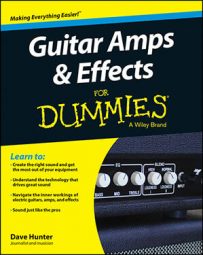A guitar pickup’s magnet or magnets provide(s) the power that enables it to do its thing by sensing the movement of the guitar’s steel strings when you play.
Different types of guitar pickups use different numbers of magnets, usually one, two, or six, depending on their design. If just one or two magnets are used, they are usually found as bar magnets mounted beneath the pickup’s coil, which charge steel pole pieces running through the coil.
Sometimes, though, the pole pieces are themselves magnets, which means one is required for each string, or two per string if it’s a humbucker. On some occasions, though, a single bar magnet is used inside the coil itself, also doubling as a blade pole piece for all strings together.
![[Credit: Photograph by Dave Hunter]](https://www.dummies.com/wp-content/uploads/444559.image0.jpg)
Because every little variation in pickup construction makes a difference to its sound, the type and positioning of the magnets is significant.
Magnets of different compositions are also used in different pickup designs, and these play a big part in shaping these components’ sounds, too. Following are the main types and their characteristics:
Alnico magnets: These magnets are made from an alloy of aluminum, nickel, and cobalt, mixed with iron and some other metals. Alnico was used in the vast majority of classic pickups through the 1950s and ’60s.
It comes in different compositions, with Alnico II, III, IV (though quite rare), and V used in pickup making. These run approximately from softer to stronger magnetism, leading to a bolder, firmer sound as they go up, all else being equal.
Ceramic magnets: These came into fashion in the ’70s, particularly as used in high output pickups. Ceramic magnets are more affordable than Alnico and also can be stronger, proportionally, so they are often used to create “hot” pickups that drive an amp hard. They are also used by several makers, though, in smaller quantities to produce creative designs where space is tight.
Lesser-seen alternatives: Rubberized-ferrite magnets were used in many cheaper pickups of the ’60s, such as the great-sounding Teisco gold foil pickups that have developed a major following (and therefore aren’t so cheap anymore!). Powerful “rare earth” magnets such as neodymium are used in some ultra-modern designs. All alternative types of magnets induce different sonic properties according to their magnetic strength and the ways in which they are used.

